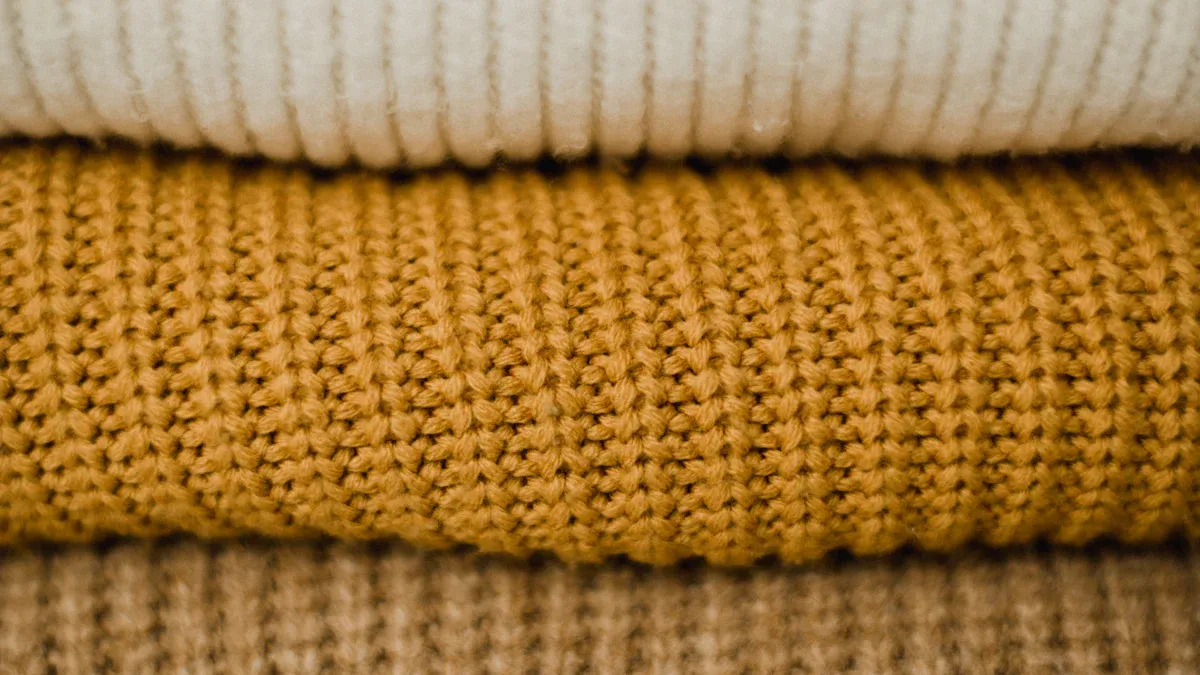
Imagine you are making a new clothing line. You need to pick the right fabric for each season. Choosing Knit Fabrics that fit the weather keeps you comfy. It also helps your clothes work better. Textile research shows these things:
Mesh structures in knits let more air pass through. They also help control moisture.
Different yarns in fabric layers move sweat away from your skin.
Finer fibers make you feel warmer or cooler as needed. These features help with breathability, drying, and cooling. These things are important for comfort and style.
Key Takeaways
Pick knit fabrics by looking at fiber type, weight, and breathability. This helps you choose what works best for each season. Lightweight knits like cotton and linen are good for summer. They help you stay cool. Thick wool and fleece are better for winter. They help you stay warm. Layering with different knits is helpful in spring and fall. It keeps you comfortable when the weather changes. Find knit fabrics that handle moisture well. This keeps your skin dry and comfy all day. Choose sustainable knit fabrics like organic cotton and Tencel. These are good for the environment and still feel nice and last long.
Choosing Knit Fabrics: Key Considerations
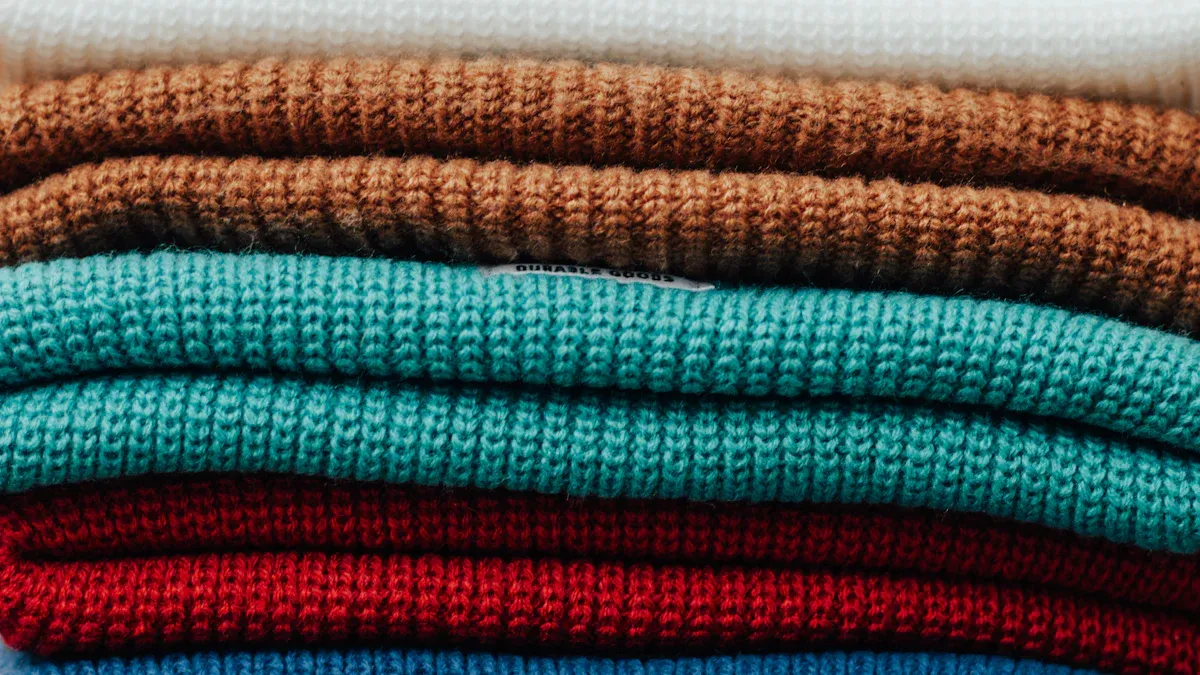
When you pick knit fabrics, think about a few things. These things change how your clothes feel and look. They also change how your clothes work in each season. Let’s look at the main things to help you choose well for any weather.
Material Types
The fiber in your knit fabric is very important. Cotton, wool, linen, and synthetic blends are all different. Cotton is soft and lets air in, but it keeps water. Wool is warm and handles water better, so it is good for cold days. Linen feels cool and dries fast, so it is nice for summer. Synthetic fibers like polyester and nylon make fabric strong and stretchy. Blends mix the best parts of each fiber.
Here’s a table that shows some knit fabric types and their main features:
Knit Fabric Type | Texture/Feel | Elasticity | Thickness | Breathability | Typical Uses | Common Fibers |
|---|---|---|---|---|---|---|
Jersey | Smooth, soft | Moderate | Thin-Medium | Good | T-shirts, dresses | Cotton, blends, synthetics |
Rib Knit | Ribbed, stretchy | High crosswise | Medium | Good | Cuffs, collars, sweaters | Cotton, wool, blends |
Interlock Knit | Smooth, stable | Moderate | Medium | Moderate | Dresses, tops, babywear | Cotton, blends |
Cable Knit | Chunky, textured | Low | Thick | Moderate | Sweaters, scarves | Wool, blends |
Mesh Knit | Open, airy | Moderate | Thin | Excellent | Sportswear, linings | Polyester, nylon |
Fleece Knit | Soft, fuzzy | Low | Thick | Low | Hoodies, jackets | Polyester, blends |
Each knit fabric type is good for something special. Picking the right material helps your design fit the season.
Fabric Weight
Fabric weight tells you if a knit is heavy or light. It is measured in ounces per yard or grams per square meter. The right weight keeps you comfy in any season.
Weight Category | Weight Range (oz/yd) | Seasonal Use | Description |
|---|---|---|---|
Lightweight | < 4 | Summer | Thin, airy, soft drape |
Midweight | 4 – 8 | Spring, Fall | Balance of warmth and breathability |
Heavyweight | > 8 | Winter | Thick, warm fabrics like fleece |
Lightweight knits like mesh or rayon jersey are best for hot days.
Midweight knits such as merino wool or interlock are good for spring and fall.
Heavyweight knits like wool or fleece keep you warm in winter.
Picking the right weight helps you stay warm or cool.
Breathability
Breathability means how well air and water move through fabric. This is important for comfort, especially when it is hot or you are active. The way the knit is made matters more than the fiber. Mesh knits and some jersey knits let air move easily. Fleece knits that are tight keep heat in.
Tests show that knits with press loops every second column and a bumpy surface (like 1B–4B group) let the most air through. These fabrics handle water well and keep you dry.
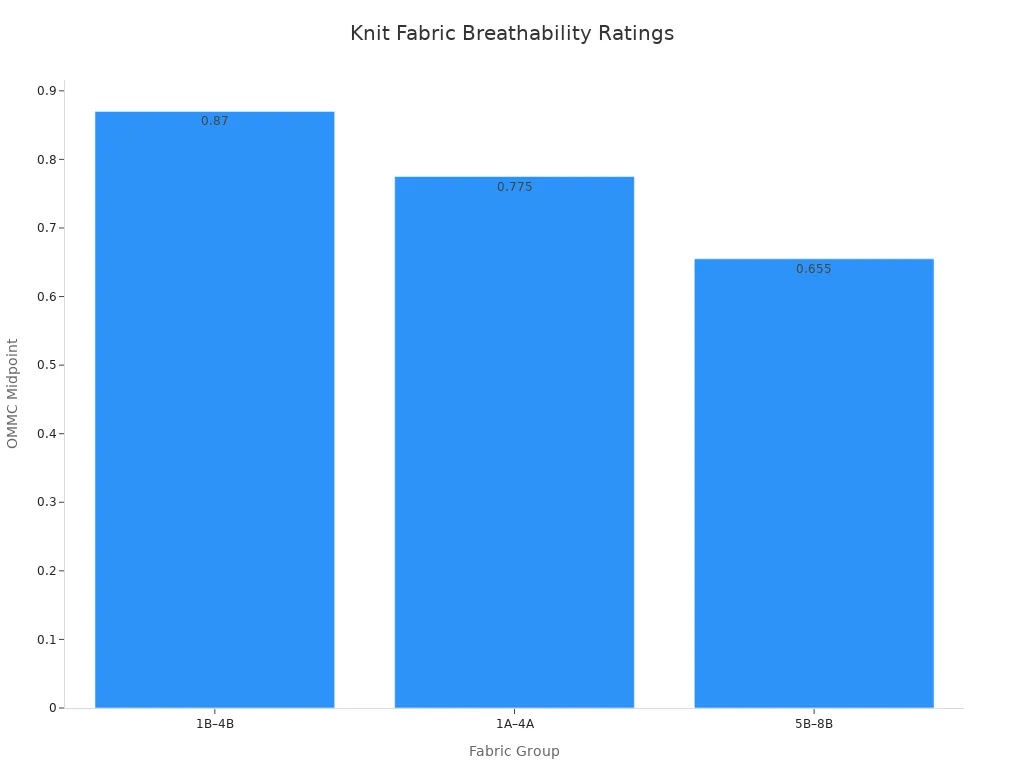
You can check breathability by testing how much air and water go through the fabric. These tests help you know if a fabric is good for summer or sportswear. Look for high breathability numbers when you need cool clothes.
Insulation
Insulation keeps you warm by holding air in the fabric. Thick knits with more air pockets, like cable knits or double jersey, keep you warmer than thin knits. Wool blends are the warmest, then aramid and polyester blends. The knit style matters too. Double Lacoste or rib knit hold more air than single jersey.
Fabric Type | Thermal Resistance (Rct) (m²·°C/W) | Insulation Ranking |
|---|---|---|
Wool blend fabric | Highest (above 0.051) | Best insulator |
Aramid-CV FR blend fabrics | ~0.051 | Second best |
PES-CV blend fabric | >0.037 | High insulation |
PES-CO blend fabric | >0.037 | High insulation |
Polyester fabrics | Lowest (~0.0052) | Least insulating |
For winter, pick thick, fluffy knits with high insulation. For summer, choose lighter, open knits.
Care and Durability
You want your clothes to last and look nice after washing. How long they last depends on fiber strength, how tight the knit is, and finishing. Synthetics like polyester and nylon are strong and keep their shape. Wool and cotton need gentle care but can last if you treat them well. Blends often give you both strength and comfort.
Fabric Type | Washing Method | Water Temp | Drying Method | Ironing | Special Notes |
|---|---|---|---|---|---|
Cotton | Hand/machine wash | Warm/cold | Tumble dry allowed | High temp safe | Wash colored cottons cold to prevent fading |
Wool | Dry clean/hand wash | N/A | Lay flat to dry | Low heat | Avoid dryer; can shrink/distort |
Synthetics | Machine wash | Cold recommended | Air dry/tumble low | Usually not needed | Cold water prevents fiber weakening |
Tip: Always read care labels and use gentle wash cycles. Turn clothes inside out to stop rubbing. Do not use high heat or your clothes may shrink or get ruined.
Picking knit fabrics that are easy to care for and strong helps your clothes last many seasons.
Spring Knits
Best Fabrics for Spring
Spring brings changing weather. You need fabrics that keep you comfortable as temperatures shift. Lightweight and breathable knits work best for this season. Fashion industry experts highly recommend crepe knit fabric for spring. Crepe knit feels soft and has a unique texture. It lets air flow, so you stay cool when the sun comes out. You can use crepe knit for dresses, tops, and pants. This fabric gives you comfort and style at the same time. Designers love crepe knit because it works well across different seasons.
Cotton knits also make a great choice for spring. Cotton feels gentle on your skin and allows your body to breathe. Cotton-wool blends add a bit of warmth for chilly mornings. Fine merino wool offers softness and light insulation without feeling heavy. These fabrics help you build a spring wardrobe that feels fresh and easy to wear.
Tip: Choose fabrics that move moisture away from your skin. This keeps you dry and comfortable all day.
Layering Tips
Spring weather can change quickly. Layering helps you adjust to cool mornings and warm afternoons. Textile specialists say you should start with a breathable base layer. Cotton or linen works well here. These fabrics manage moisture and keep you comfortable. Next, add a lightweight sweater or vest as your middle layer. This gives you warmth without making you feel bulky. Finish with a blazer or trench coat to protect yourself from wind or rain.
Start with a fitted cotton or linen base layer.
Add a lightweight knit sweater or vest for insulation.
Top with a tailored blazer or trench coat for protection.
Mixing textures and keeping a simple color palette makes your outfit look stylish. Make sure each layer fits well. This avoids bulk and lets you move easily. Spring knits give you the flexibility to dress for any weather the season brings.
Summer Knits
Cool and Breathable Options
When it gets hot, you want to feel cool. Summer knit fabrics help with this. These fabrics have tiny loops that let air move. This keeps your body cool on hot days. Summer knits feel soft on your skin. They also stretch, so you can move easily. Many designers pick cotton, linen, bamboo, and silk knits for summer. These fibers let your skin breathe and stop irritation.
Cotton knits are good for t-shirts and dresses. Linen knits feel light and dry fast, so they are great for humid days. Bamboo knits feel silky and help you stay cool. Silk knits feel fancy and cool to the touch. You can use these fabrics for activewear, tops, or light cardigans. Each fabric gives you comfort and style for summer.
Tip: Pick light colors for summer knits. Light colors reflect the sun and help you stay cool.
Moisture Management
It is important to stay dry in summer. Summer knits use special ways to handle sweat and moisture. Many new knits have tiny spaces and raised loops. These help sweat move away from your skin and dry fast. Some fabrics use mesh stitching with tiny holes for more airflow.
Special finishes like water-repellent coatings make water roll off the fabric.
Synthetic fibers like polyester and nylon pull sweat away and dry quickly, so they are good for sportswear.
Natural fibers like Merino wool, Tencel, and modal blends feel nice and help stop bad smells.
New ways, like nanospinning cellulosic fibers, make channels that move sweat out fast.
Moisture control in summer knits keeps your skin dry. It also stops you from feeling sticky in humid weather. Fabrics that let air and water vapor pass help your body cool down. This means you feel good, even on long, busy days outside.
Fall Knits
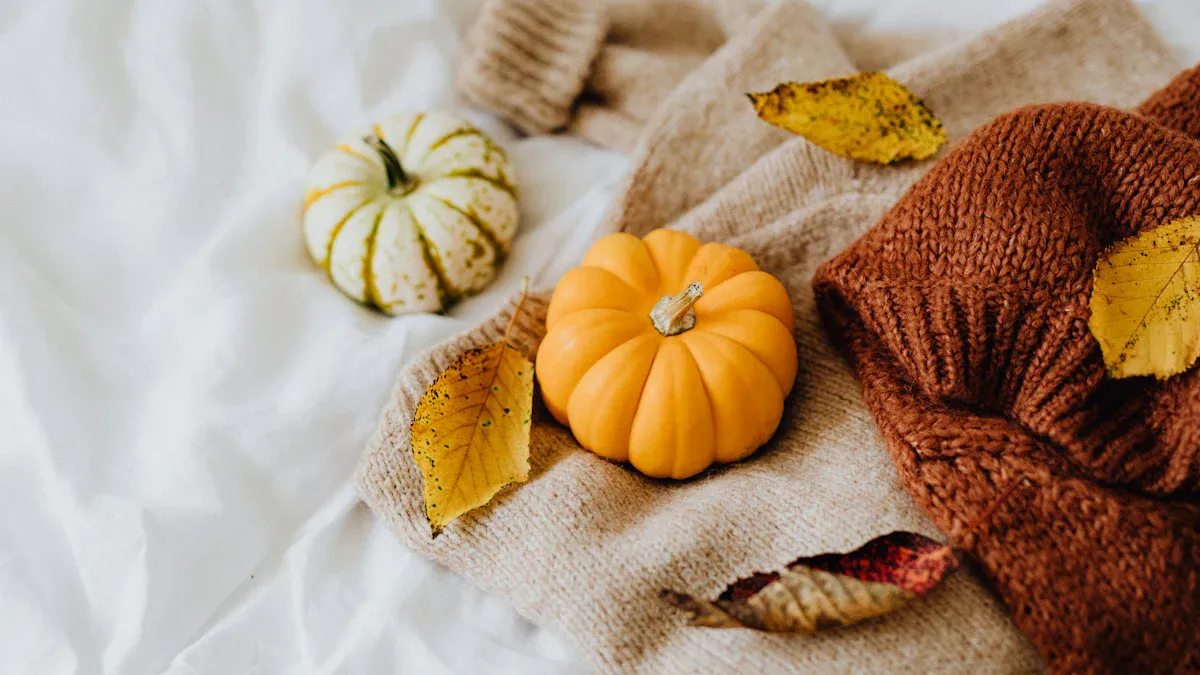
Transitional Fabrics
Fall has cooler air and changing weather. You need knit fabrics that keep you comfy as it gets colder. Designers often pick cotton-wool blends, light wool, and other knits for fall. These fabrics give you warmth but do not feel heavy. They also let your skin breathe, which helps when the weather changes during the day.
Fashion reports say people want eco-friendly and useful knits. Nylon and polyester blends are now very popular. These blends are good for the planet and work well for travel and sports. You see more simple and technical fabrics in fall styles. They look nice and work well.
Here is a table of the most popular transitional knit fabrics for fall:
Fabric Type | Description | Example Brands/Items |
|---|---|---|
Popular for co-ord sets, versatile for fall layering | The Frankie Shop (cream Jules wool blend cable knit set) | |
Stretch-knit fabrics | Comfortable, form-fitting sets suitable for transitional weather | Balmain (stretch-knit set) |
Cotton-blend knits | Lightweight, breathable cardigans and knitwear | Ganni (cotton-blend cardigan), Love Shack Fancy (beach graphic cardigan), For Love and Lemons (floral cardigan) |
Cashmere and wool blends | Luxurious, warm cardigans with embellishments for special occasions | Versace (embellished distressed cashmere and wool-blend cardigan), Jacquemus (La maille Pralù cardigan) |
Lightweight knits | Versatile pieces like vests, dresses, crop tops for layering in transitional seasons | House of Sunny (Cypress set), Christopher Esber (Melange knit co-ord), Fendi (FF Vertigo cardigan and skirt) |
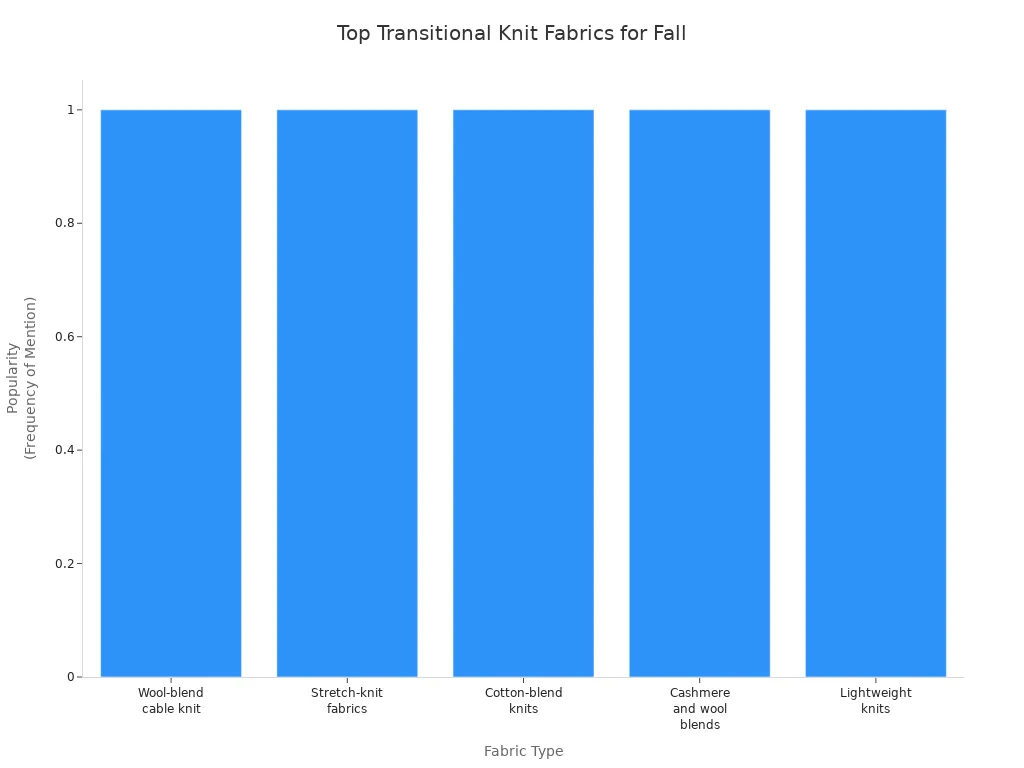
These fabrics help you make outfits that work for fall’s changing weather.
Layering and Texture
Layering is important in fall. You can add or take off clothes as it gets warmer or colder. Pick knits that go well together. Cotton-wool blends and light wool are good for base layers. Put on a thick cardigan or vest for more warmth.
Texture matters for both warmth and style in fall. Here are some ways texture helps:
Cable knits, jacquard, and waffle weaves make your outfit look cool.
Thick and big knits with chunky yarns keep you warm.
Soft materials like cashmere blends and brushed wool feel nice and keep heat in.
Textured knits turn plain sweaters into stylish fall clothes that are comfy and useful.
Try mixing textures in your layers. This keeps you warm and makes your fall outfits look special.
Winter Knits
Warmest Materials
When winter comes, you need knit fabrics that keep you warm. Textile engineers say wool and fleece are best for cold weather. Wool, like Merino, Cashmere, and Alpaca, holds heat because it has tiny air pockets. These fibers feel soft and let your skin breathe. They also move some moisture away from your skin. Wool is light but still keeps you warm, so you do not feel heavy.
Fleece fabrics, such as Polar Fleece, Microfleece, and Sherpa Fleece, are also good for winter. Fleece feels soft and dries fast. It pulls sweat away from your body, so you stay dry when you are active. Polyester-based knits use special knitting and finishes for better moisture control and strength. You might pick wool for comfort and warmth when the weather changes. For lots of activity or wet days, polyester fleece dries fast and works well.
Tip: Wear heavier knits on top and lighter knits underneath. This helps you stay comfortable inside and outside.
Insulation Strategies
To stay warm in winter, you should wear layers. Each layer does something important. The right materials and fit help a lot.
Layer | Purpose | Recommended Materials | Fit and Notes |
|---|---|---|---|
Holds warmth, moves moisture | Merino wool, technical synthetics | Fits close, tucks in, keeps heat in, skip cotton | |
Middle Layer | Adds warmth, traps body heat | Wool, fleece, cashmere | A bit loose, holds warm air, lets skin breathe |
Outer Layer | Blocks wind, rain, and snow | Waterproof, breathable fabrics | Loose fit, can adjust to keep out cold |
Start with a close-fitting base layer made of Merino wool or synthetic fabric. This layer keeps sweat off your skin and holds in warmth. Add a middle layer, like a wool or fleece sweater, to trap more heat. Finish with a loose outer layer that blocks wind and water. All the layers work together to keep you warm, dry, and comfy all winter.
Year-Round Knit Wardrobe
Versatile Choices
You can make a wardrobe for every season by picking the right knit fabrics. Knitted fabrics have loops that let air move through them. This helps you stay cool in summer and warm in winter. Knits also stretch, so your clothes fit better and move with you. You can wear knit clothes for many things, like relaxing or working out.
Some knits are great for all year:
Cotton cardigans keep you warm at night and feel soft in the sun.
Short-sleeved sweaters are good for layering in spring and fall.
Rib-knit dresses made from cotton or wool look nice and feel comfy in any weather.
Merino wool sweaters help control your body heat, so you can wear them alone or with other layers.
French terry feels soft and has loops on the back, so it is warm and lets air in.
Knit scarves made from cotton or light wool add style and comfort in every season.
Knit fabrics come in different weights and textures. You can pick light knits for hot days and heavier ones for cold days. This makes it easy to mix and match your clothes all year.
Sustainable Options
You can help the planet by choosing eco-friendly knit fabrics. Many brands now use materials that are better for nature. These include organic cotton, bamboo, hemp, and recycled fibers. Some companies use old plastic and fabric scraps to make new knitwear. Others save energy in their factories.
Here is a table of sustainable knit fabrics and what makes them special:
Fabric | Source & Description | Advantages | Price Range |
|---|---|---|---|
Hemp | Plant stalks, durable, breathable | Low water use, carbon negative, strong | $6–$35/yard |
Tencel (Lyocell) | Wood pulp, soft, closed-loop process | Eco-friendly, soft, biodegradable | $5.61–$28/yard |
Banana Fiber | Banana tree stems, natural, biodegradable | Durable, low-impact, biodegradable | $4.20–$570/kg |
Sustainable knit fabrics can be just as comfy and strong as regular ones. For example, Tencel and bamboo knits feel soft and keep you dry. Recycled polyester and organic cotton blends are strong and stretchy. When you pick these fabrics, you help the earth and make a wardrobe that lasts.
Picking Knit Fabrics for each season means you think about fiber, weight, and how the fabric is made. You should use wool or cashmere when it is cold because they keep you warm. Choose cotton or linen for hot days since they feel light and cool. Blends work well in spring and fall when the weather changes. If you pick knits that fit the weather, you will feel comfortable and look good. This also helps the planet.
Fashion professionals: Check what each fabric can do, try out new blends, and make sure the quality is high. This helps you meet what customers want and makes your brand strong.
FAQ
What is the best knit fabric for hot weather?
You should choose lightweight knits like cotton, linen, or bamboo. These fabrics let air move and help you stay cool. Light colors work best in the sun.
How do I care for wool knit fabrics?
Always wash wool by hand or use a gentle cycle with cold water. Lay the fabric flat to dry. Avoid high heat and wringing to keep the shape and softness.
Can I use one knit fabric for all seasons?
You can pick versatile blends like cotton-wool or merino wool. These fabrics work well in many climates. Layering helps you adjust to temperature changes.
What makes a knit fabric breathable?
Breathable knits have open structures or mesh designs. These let air and moisture pass through. Fabrics like jersey, mesh, and lightweight rib knits offer good breathability.
Are sustainable knit fabrics as durable as regular ones?
Many sustainable knits, such as organic cotton or Tencel, offer strength and comfort. You get durability and eco-friendly benefits. Always check the care label for best results.









